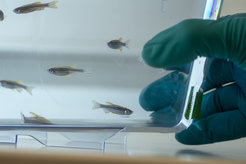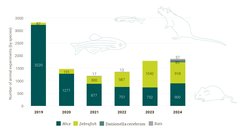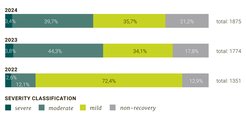Animal experiments in 2023
April 24 is World Day for Laboratory Animals. We are taking this day as an opportunity to publish the animal experiment figures of the Max Planck Institute for Infection Biology. The majority of animal experiments at the Institute in 2023 were carried out on mice and zebrafish for research into the infectious diseases tuberculosis and typhoid fever.

In 2023, a total of 1774 animal experiments were carried out at the Max Planck Institute for Infection Biology, around 30% more than in the previous year (2022: 1351 animal experiments). This increase is due to a higher number of zebrafish experiments for tuberculosis research, while the number of experiments on mice remained constant compared to the previous year. Mice were mainly used at the institute to research the infectious disease typhoid fever. In contrast to 2021 and 2022, no rats were used for experiments at the Institute in 2023. The increasing number of zebrafish experiments continues the trend of previous years, as research group leader Mark Cronan has further expanded tuberculosis research with his "In Vivo Cell Biology of Infections" research group established in 2021.
Tuberculosis research on zebrafish expanded
Tuberculosis one of the most common causes of death from a single pathogen and more than ten million people are infected with tuberculosis every year. Mark Cronan's research group is investigating so-called tuberculosis granulomas—nodular clusters of immune cells that form around tuberculosis bacteria. These cell clusters restrict the ability of immune cells and antibiotics to reach the bacteria they contain, making it more difficult to treat the disease. One goal of tuberculosis research is therefore to better understand the granulomas to develop therapies against the enclosed bacteria.
Due to the complex interaction between pathogens and immune cells, the development of granulomas can only be investigated in living organisms. In humans, granulomas usually form in the lungs. Although zebrafish do not have lungs, they form structures that are very similar to human granulomas when infected with tuberculosis. Mice also develop these structures, but they are very different from human granulomas. For these reasons—and others such as handling and biosafety—, zebrafish are often used in tuberculosis research. Thanks to this model, researchers have already been able to answer many questions about granulomas and the processes involved during infection.

To study tuberculosis granulomas, the members of the research group infect zebrafish with the bacterium Mycobacterium marinum, a close relative of the human tuberculosis pathogen. The fish fall ill with the pathogen and develop granulomas, which is why the experiment is categorised as moderate severity in the legal classification. Further information on the severity levels of animal experiments can be found here.
In addition, many experiments were carried out on zebrafish for genotyping. The researchers use these tests to check the composition of the fish's genetic material. For example, they can determine whether genetic modification has been successful. To obtain genetic material for the study, it is sufficient to swab the scales. As the fish are placed in a separate tank and material is swabbed from the skin surface, this process must also be applied for and recorded as an animal experiment. The tests are categorized as mild stress procedures
Number of mouse experiments remains constant
Compared to previous years, the number of mouse experiments has remained almost constant. In 2023, 732 mice were used in experiments, compared to 751 mice in 2022. Most experiments with mice were carried out at the Institute for research on typhoid fever. Every year, more than ten million people contract typhoid fever and more than 100,000 die from it. The researchers in the research group Cellular Microbiology want to use typhoid fever as a model disease to investigate fundamental mechanisms of infectious diseases. In typhoid fever, there are people who become infected, tolerate the pathogen and are highly infectious to others, but do not develop symptoms themselves. This phenomenon of "silent carriers" also occurs in other infectious diseases and has been little studied.

For a detailed explanation of stress levels in animal experiments, including the legal requirements and examples of stress levels, see the page of the Initiative Tierversuche Verstehen.
As with tuberculosis research, certain aspects of the complex interplay between infectious agents and the immune system can only be investigated in living organisms. Due to their genetic proximity to humans, mice are used for the experiments. The scientists at the Institute investigate which genetic differences are responsible for the reactions to an infection. In other words, why some mice become ill when infected, others develop no symptoms and are not contagious, while still others develop no symptoms and can still pass on the pathogens. For the experiment, the animals are infected with the mouse typhoid fever pathogen, Salmonella typhi, and the course of the disease is continuously monitored. Depending the severity of the symptoms, the experiment is categorised as either mild, moderate or severe for the respective mouse.
To make experiments comparable, mice for animal experiments are usually genetically standardized. However, in the search for the mechanistic basis of tolerance to disease, researchers are particularly interested in genetic diversity. Therefore, they use a special mouse population that mimics the genetic differences between individuals within the human population.
Animal experiments are still indispensable in biomedical research—also at the Max Planck Institute for Infection Biology. They represent an important part of the experimental method spectrum, especially for research on the complex mechanisms of our immune system.
Even if the development of alternative methods is progressing steadily and some animal experiments can now be replaced or reduced. A complete replacement of animal experiments is not currently foreseeable.


